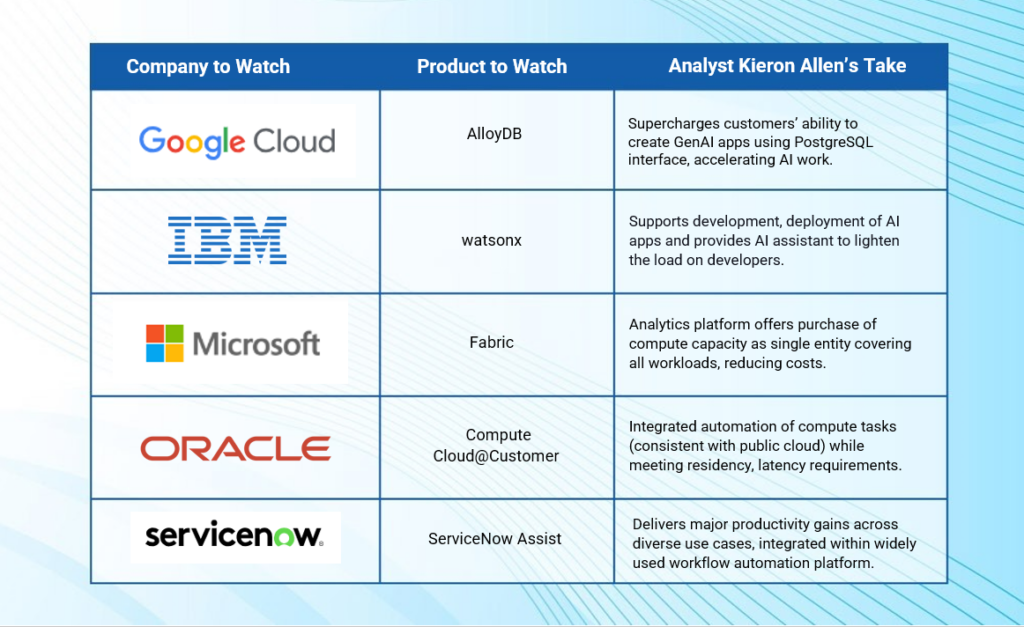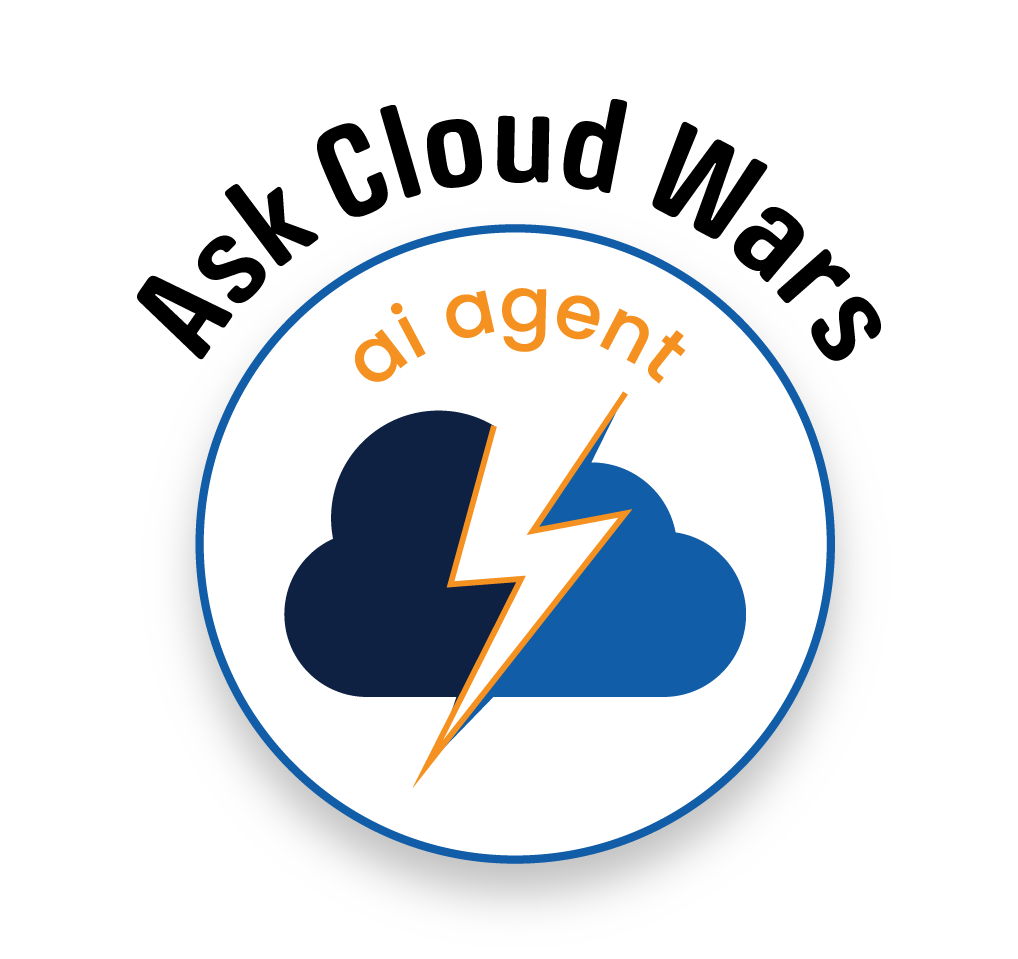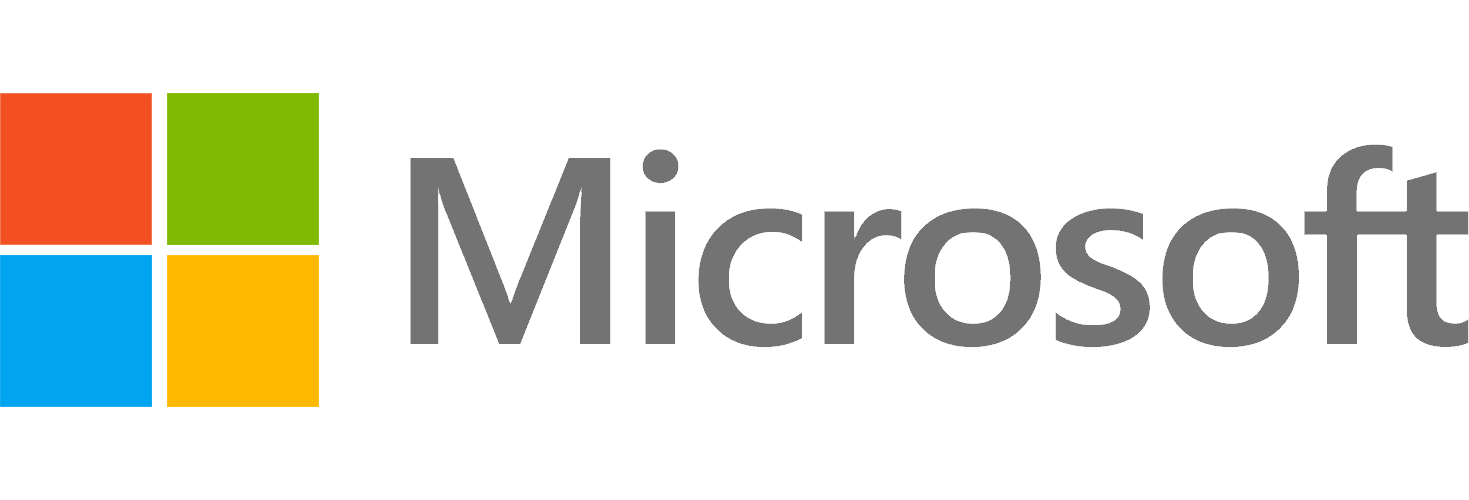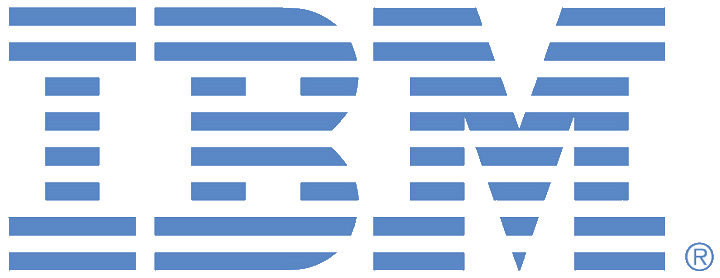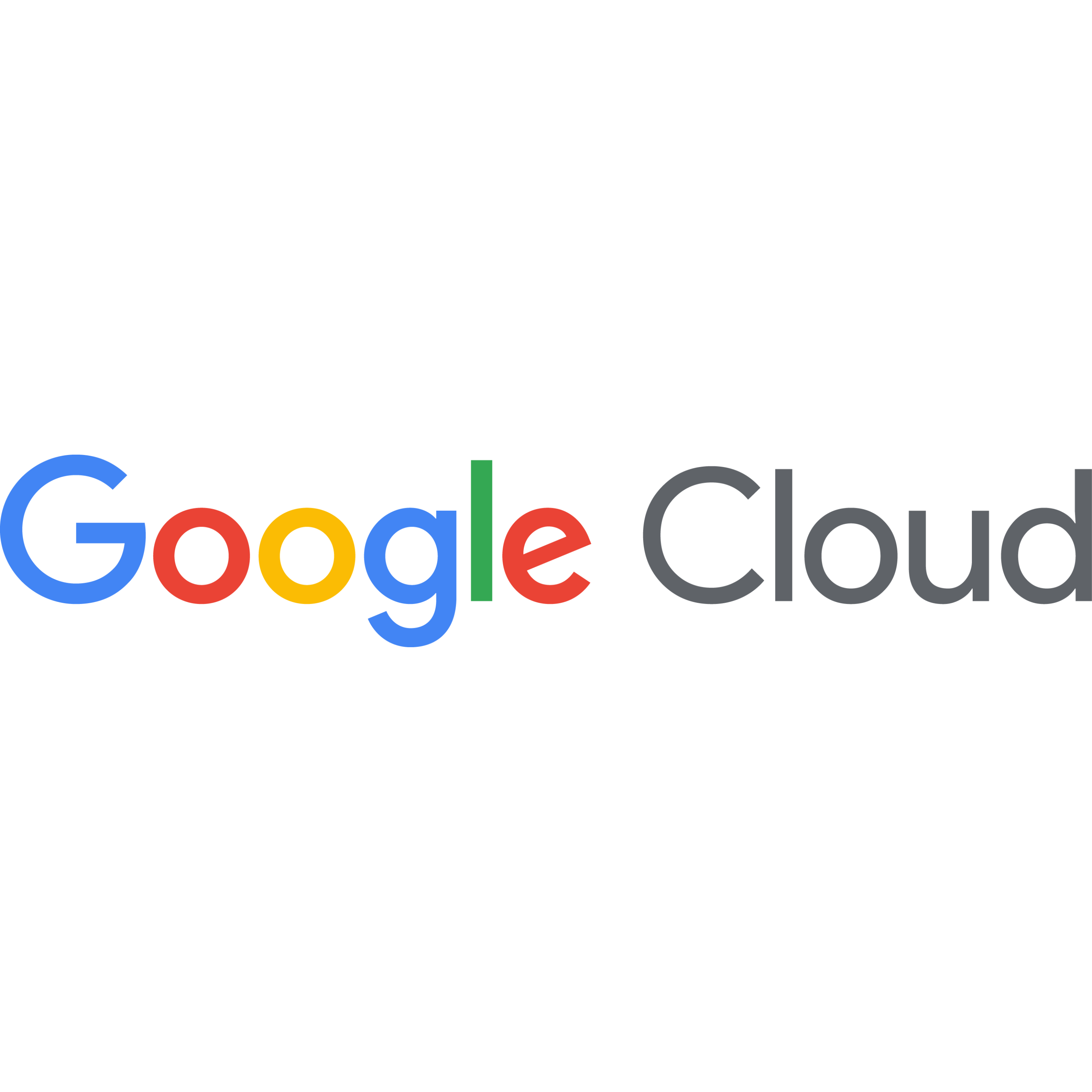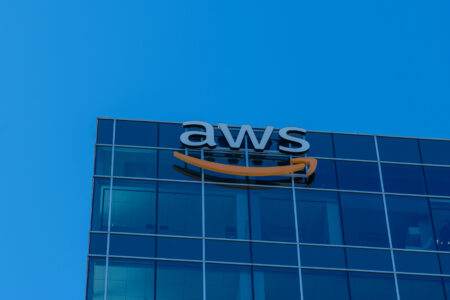
The calendar recently turned to 2024, but the Cloud Wars didn’t relent over the recent holiday celebrations. The companies that comprise the Cloud Wars Top 10 continue to innovate, announcing and delivering a steady stream of groundbreaking products throughout 2023.
With such a rapid pace of innovation, brought about in no small part by the generative artificial intelligence (GenAI) juggernaut, the past year has seen the world’s leading cloud companies redefine the boundaries of productivity, accelerate the power of data, and democratize access to technology in a way we’ve never seen before.
Given the breadth of product lines maintained by these tech giants, it’s a daunting undertaking to try to isolate just five to watch in 2024, so we’re focusing on five that are worth considering while acknowledging many other merit consideration by technology and business leaders.
Our list includes best-of-breed cloud technologies and products that differentiate the vendors from their competitors in the Cloud Wars Top 10 and more broadly.
Google Cloud: AlloyDB
Despite launching in 2022, Google Cloud’s AlloyDB has emerged as one of the best cloud databases for the GenAI era because it covers virtually all the bases and addresses the data modernization efforts required by companies that wish to compete for GenAI customers.
As well as offering exceptional speed and scalability, AlloyDB is flexible, providing customers with the security, availability, and performance to migrate to the cloud from legacy databases and thrive in this new operating environment.
Google Cloud developed AlloyDB because many organizations migrated from legacy relational databases to more cost-efficient and flexible open-source alternatives, most commonly PostgreSQL.
As such, customers using AlloyDB benefit from a fully Postgres-compatible database that comes with enterprise-grade performance, availability, scalability, and flexibility, and has been explicitly designed for multi-cloud and hybrid environments.
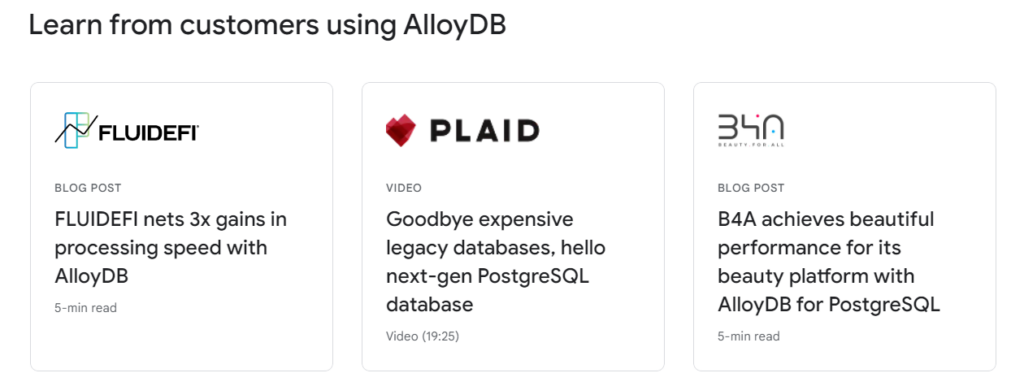
Key AlloyDB features
- AlloyDB AI (currently in preview) is supercharging the capabilities of AlloyDB users to create GenAI applications using the widely used PostgreSQL interface. This will help users capitalize on the power of AlloyDB to accelerate GenAI work.
- Fully managed and complete with machine-learning- (ML-) powered automation, such as backups and capacity management, AlloyDB provides a comprehensive and powerful cloud database that doesn’t require the heavy lifting of many alternatives.
- AlloyDB supports data modernization through its multi-cloud and hybrid architecture compatibility and, most recently, through AlloyDB Omni, a downloadable version of AlloyDB that can run on-premises, at the edge, across multiple clouds, or on developer hardware.

Google Cloud’s AlloyDB is soaring in popularity because it gives customers the scale, performance, and security of their legacy databases while also offering open-source flexibility and innovation.”
Cloud Wars Founder Bob Evans
IBM: watsonx
While IBM’s Watson has been a long-time AI focus for the computing giant, watsonx launched in May 2023, building on this work to provide an enterprise-grade AI and data platform for the GenAI era. The aim of watsonx is to enable companies to deploy, scale, and manage AI workflows.
In addition to three core components (see “key features” below), watsonx includes a series of pre-built applications that serve as AI assistants. With this complete functionality, organizations have a suite that not only ensures the development and deployment of AI products in one place but supports each function with an AI assistant to increase productivity and lighten the load on developers.
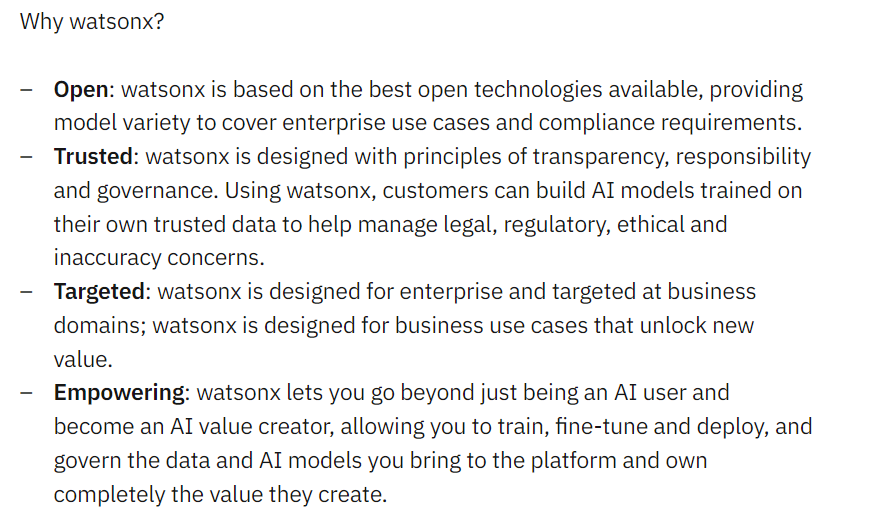
Key features
- watsonx.ai provides a studio for foundation models, GenAI, and machine learning that enables users to build and deploy applications easily. There are also functions for training and validation, ensuring that AI developers can complete builds across the entirety of the application lifecycle.
- watsonx.data is designed for scalable analytics and AI workloads and enables users to access all data through a single point. Built on an open lakehouse architecture with integrated governance, IBM positions watsonx.data as the only data store that is open, hybrid, and governed.
- IBM supports responsible AI in watsonx with watsonx.governance. This feature enables users to manage and monitor compliance, risk mitigation, and the lifecycle of AI workflows across GenAI and ML applications and models.
There are still many billions of lines of COBOL code out there. A version of watsonx Code Assistant, an IBM GenAI product, is able to come in and modernize some of that COBOL.”
Bob Evans
Microsoft Fabric
As Big Data has graduated from a buzzword to an integral business asset, the problem with disparate data sources and analytics engines has grown. Microsoft Fabric has emerged as a solution to these issues, providing an end-to-end analytics platform that unifies various analytics and data tools into one platform.
Microsoft Fabric includes a complete toolkit encompassing Microsoft data and analytics tools such as Power BI and Azure Synapse Analytics. It is fueled by Azure OpenAI Service, enabling users to leverage GenAI to unlock insights. Microsoft launched Fabric in response to the AI revolution, and the software-as-a-service (SaaS) platform has been designed to help users maximize the potential of their data in the AI era.
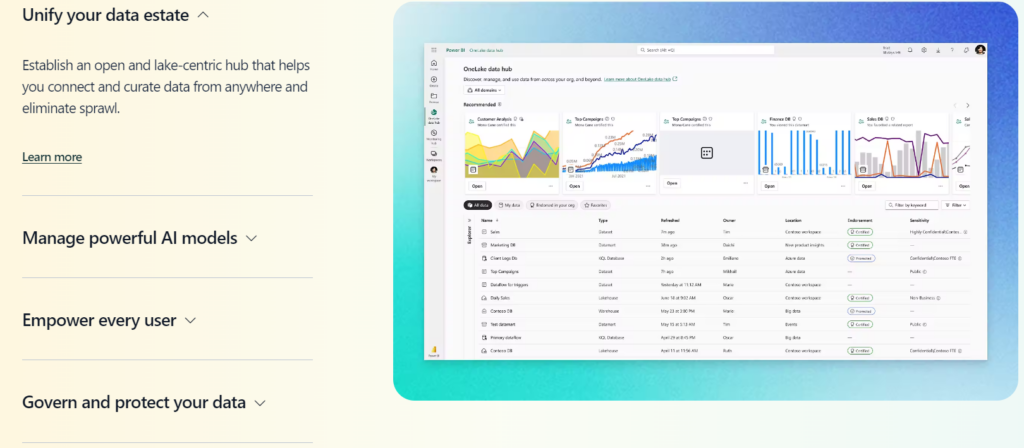
Key features
- Microsoft Fabric provides a complete ecosystem for data analytics in a single platform. This cohesion takes away a huge barrier to productivity. It brings together various Microsoft technologies that are widely used by data departments and business users across every industry.
- Microsoft Fabric is centered on Microsoft’s OneLake data lake product, which supports structured and unstructured data.
- Fabric enables users to reduce costs by offering the purchase of compute capacity as a single entity covering all workloads and applications on the platform. This means when computing isn’t utilized in one area, it can be transferred to another.

“With Microsoft Fabric, the company is democratizing the corporate data estate while managing powerful AI models and governing data across the organization.”
Bob Evans
Oracle: Compute Cloud@Customer
Enterprise operations are no longer centered in a specific location. This is a challenge that cloud technologies are meeting head-on. However, even when a customer transitions to the cloud, distributed data issues don’t stop. Vendors must consider public, private, and multi-cloud architectures and, most significantly, the requirements of their customers.
To that end, Oracle’s Compute Cloud@Customer meets customer demands by providing another option for computing services via their own data centers. This relatively new offering from Oracle enables customers to run OCI computing and storage services in their data centers, resulting in cost reductions resulting from consumption-based pricing and having management requirements managed by Oracle.

Key features
- Compute Cloud@Customer enables customers to realize the same benefits, such as integrated automation and simplification of compute tasks, as experienced by customers using public OCI Dedicated Regions. However, Compute Cloud@Customer is more compact, covering the same data residency and latency requirements while providing plenty of power in a more manageable package.
- Customers are charged on a consumption-based pricing model ensuring Cloud@Customer is cost-effective. It’s also versatile: customers can upscale cloud-native apps and run and reconfigure Oracle and third-party apps at scale
- Features always-on encryption for maximum data protection.
The value of Oracle’s Cloud@Customer architecture is validated by big customers including Deutsche Bank, which disclosed in 2023 that it transferred 1,300 databases to the cloud.
Bob Evans
ServiceNow: Now Assist
During 2023, ServiceNow brought many additions to its Now Platform, the company’s flagship workflow automation suite. Most impactful was the release of Now Assist, with generative AI functionality to accelerate the development and operationalization of generative AI projects.
The Now Platform was already an outstanding success. Still, as 2023 progressed, ServiceNow extended the capabilities of Now Assist to ensure it became one of the leading business enablers for companies looking to capitalize on generative AI. Today, Now Assist brings generative AI capabilities for various use cases, including IT Service Management, Field Service Management, Customer Service Management, HR Service Delivery, and creators or developers.
Regarding generative AI features, Now Assist includes case, incident, and chat summarization, the ability to summarize resolution notes, AI search, flow generation, and support for Virtual Agent.


Key features
- The most significant benefits of Now Assist are the productivity and efficiency gains the technology provides. Integrated generative AI technology helps expedite workflow consolidation, while Now Assist for Creators provides these features for miscellaneous tasks and development projects.
- Now Assist Recommendations enable users to quickly build workflows, tapping into one of the core benefits of generative AI technology: gaining deeper, more beneficial insights more quickly. Over time, these recommendations improve with training, creating a bespoke recommendation engine for your organization.
- Organizations can use Now Assist to reduce costs. This is achieved through the automation of tasks, lowering the cost of labor, and through data-driven insights unearthed by Now Assist tools.
- A powerful ecosystem of AI partners that are working with the company to maximize the reach and impact of its AI technology.
“Partners help customers deploy GenAI, develop use cases, and push the ServiceNow platform beyond where the company would have pushed it alone.”
Bob Evans
More Analysis on Top Products for 2024:
- 5 Generative AI Products to Watch in 2024
- 5 Cybersecurity Products to Watch in 2024
- 5 Supply Chain Products to Watch in 2024
Ask Cloud Wars AI Agent about this analysis


